|
|
 |
Chinese houses, cities and palaces are build following the belief in natural spirits. This thinking is called Fengshui 風水 "Wind and Water". Much of this thinking is not pure superstition but has is origin in geographical and climatical conditions - that may be very different outside of China. The north is seen as a direction where bad and unauspicious winds blow and demons may enter the house. For this reason, Chinese houses show no northern entrance, the palace and city gates in the north are always closed - except during a funeral ceremony when the coffin or urn is brought out of the house. On the opposite side of a building is the main entrance, going to the south to let as much sunshine inside as possible.
Additional conditions for a building corresponding to the needs of nature would be to erect the house or the palace south of a mountain, on the sunny side, and on the north side of a river bank. These two locations are the original meaning of the two words yin 陰 and yang 陽. Yin is the shady north side of a hill or the southern bank of a river, yang the sunny south slope of a hill and the north of a river bank. The mountain to the north protects the building from cold winds and bad ghosts, the river to the south brings warm breezes and friendly wanderers with it. Every building in China is erected more or less in this kind of environment, private houses, palaces, whole cities, and even cimeteries and the imperial tombs.
The imperial palace of Beijing is one of the most admired tourist attractions of the world, and for good reasons. After the downfall of the empire in 1911 and the expulsion of the last emperor the palace served as a museum. Most parts of it have been preserved in the original shape of the Ming Dynasty buildings. The palace buildings of the former capital Nanjing were almost totally destroyed during the suppression of the Taiping rebellion. Only the city wall of Nanjing is still very impressive today. Traces of the old metropolis of Chang'an like the Ming time city wall can still be seen in Xi'an. While Hangzhou suffered the same fate like Nanjing during the suppression of the Taiping, the Song Dynasty capital Kaifeng can still present its old city wall.
The names of old palaces are still in the brains of the historian writers, like the Ebang Palace 阿房宮 (not Afang!) of the Qin, the Weiyang 未央宮 "Not Centered" and Changle 長樂宮 "Long Joy" Palaces of the Han Dynasty in Chang'an, and the Ganlu 甘露宮 "Sweet Dew", Daming 大明宮 "Great Illumination" and Taiji 太極宮 "Highest Extreme" Palaces of the Tang Dynasty.
The pattern of Chinese capital cities was copied by the peoples influenced by Chinese culture. Japanese and Korean capital cities also used to be erected in a chess-board manner, but without the huge city walls of the Chinese cities. The latest example of a copy of the Chinese capital is the capital city of the Vietnamese Ngyuen emperors in Huê whose imperial palace and tombs just look like that of the Manchu emperors.
The Forbidden City (Zijincheng 紫禁城 "Purple Forbidden City" - purple being the color of the fix polar star that symbolizes the emperor) in Beijing is framed by a square and oblong wall, flanked by four towers in the corners (jiaolou 角樓). The southern "Midday Gate" (Wumen 午門) is a large entrance complex with three gates, the middle one only to be passed by the emperor. To the north of this gate is an artificial river, created from a derived canal of the moat river called "Gold Creek" (Jinshui 金水). This canal called Neijinshui 內金水 "Inner Gold Creek" can be crossed by five bridges. The axis from south to north next passes the Gate of Highest Harmony (Taihemen 太和門) before giving space to a trinity of three buildings in the Outer Court (Waichao 外朝), called Hall of Highest Harmony (Taihedian 太和殿), the small Hall of Harmony of the Mean (Zhonghedian 中和殿), and Hall of Preservation of Harmony (Baohedian 保和殿). These three buildings serve as representative functional locations where the emperor acts as ruler and governor. Further to the north of this complex, the modern visitor passes the Gate of Sovereign Purity (Qianqingmen 乾清門). In old times, only the emperor, women and eunuchs were allowed to proceed further. Even the highest ministers were not allowed to pass this gate. In this Inner Court (Neiting 內庭), we find a second trinity of buildings, but smaller than the first complex: the big Palace of Sovereign Purity (Qianqinggong 乾清宮), the small Hall of Unification of the Highest Beings (Heaven and Earth - Male and Female; Jiaotaidian 交泰殿), and the Palace of Compliant Peace (Kunninggong 坤寧宮). Behind this complex, the northern wall of the Forbidden City is reached at the ususally closed Gate of the Martiality of the Spirits (Shenwumen 神武門). North of the wall, the Ming emperors had erected an artificial hill called "Scenery Hill" (Jingshan 景山) or "Coal Hill" (Meishan 煤山), to meet the needs of the Fengshui thought.
To the left and the right of this axis, in the inner and the outer court there are hundreds of dwelling quarters, studios for studies, magazins for food, weapons, libraries and all the needs for the administration of the Forbidden City and - the whole empire.
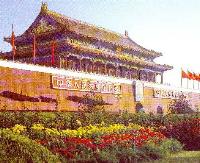 |
The Tiananmen 天安門 "Gate of Celestial Peace" belongs to the outer wall of the Forbidden City and is erected south of the Noon Gate. From this gate, Mao Zedong 毛澤東 announced the foundation of the People's Republic (Zhonghua renmin gongheguo 中華人民共和國) on October 1st, 1949. The square just south to the Gate of Heavenly Peace was widened in 1958 and is now the largest square anywhere in the world. The Square at the Gate of Celestial Peace (Tiananmen guangchang 天安門廣場) is used as platform for the official military parades. During the Cultural Revolution 文化大革命, the Red Guards 紅衛兵 defiled here to worship Mao. But often, the square served as a location for students to launch their demonstrations, like during the demonstration of May Fourth 1919 五四運動, the demonstrations against the Gang of Four 四人幫 in 1976, and the student movement of June 1989.
On top of the main entrance of the Gate, we can see now the portrait of Mao Zedong and the two plates stating "Long live the PRC" (Zhonghua renmin gongheguo wan sui) and "Long live the unity of the world's people". |
 |
The Wumen 午門 "Noon Gate" is the southern entrance of the Forbidden City. The three gates are held in a very austere style and lead a little bit tunnel-like in the outer court. The whole complex of the Noon Gate is shaped in a way that attacking people could be calmed down from three sides, quite similar to European Middle Age castles. |
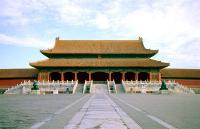 |
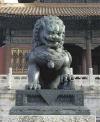 Crossing the artificial Gold Creek by one of the three bridges, visitors see the Taihemen 太和門 "Gate of Highest Harmony". All buildings of the Forbidden City are painted in red, the color of good luck. The Gate of Highest Harmony with its two storey roof is flanked by two huge bronze lions, representing the imperial power. Crossing the artificial Gold Creek by one of the three bridges, visitors see the Taihemen 太和門 "Gate of Highest Harmony". All buildings of the Forbidden City are painted in red, the color of good luck. The Gate of Highest Harmony with its two storey roof is flanked by two huge bronze lions, representing the imperial power. |
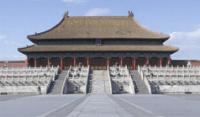
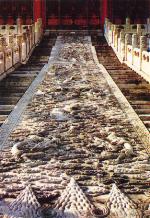 |
 Like all buildings in the Forbidden City, the Taihedian 太和殿 "Hall of Highest Harmony" has a roof covered with yellow-brown porcelain tiles. The tiles at the corners of the roof (dawen 大吻, zoushou 走獸) are shaped like dragons that are thought to protect the buildings from lightnings (see glazed tiles of the Shenyang Palace). The Hall of Highest Harmony was the throne hall of the Ming and Qing emperors. It is 27 m tall and 63 m wide. Three broad stairways lead to the platform, the middle stairway is decorated with a relief of dragons playing in water, symbols for the emperor in his dragon robe (picture to the right). Bronze turtles and cranes flanking the stairs are symbols for longevity; quite famous are also the sundial (rigui 日晷) and the standard measures (jialiang 嘉量). In front of the hall, in the wide court south of it, all high officials and dignitaries used to attend to court ceremonies. Like all buildings in the Forbidden City, the Taihedian 太和殿 "Hall of Highest Harmony" has a roof covered with yellow-brown porcelain tiles. The tiles at the corners of the roof (dawen 大吻, zoushou 走獸) are shaped like dragons that are thought to protect the buildings from lightnings (see glazed tiles of the Shenyang Palace). The Hall of Highest Harmony was the throne hall of the Ming and Qing emperors. It is 27 m tall and 63 m wide. Three broad stairways lead to the platform, the middle stairway is decorated with a relief of dragons playing in water, symbols for the emperor in his dragon robe (picture to the right). Bronze turtles and cranes flanking the stairs are symbols for longevity; quite famous are also the sundial (rigui 日晷) and the standard measures (jialiang 嘉量). In front of the hall, in the wide court south of it, all high officials and dignitaries used to attend to court ceremonies. |
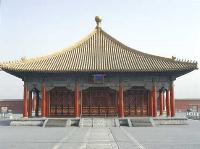 |
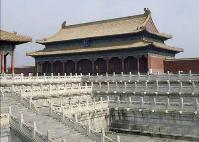 Three halls build a complex in the outer court: The Hall of Highest Harmony (above), the Zhonghedian 中和殿 "Hall of Harmony of the Mean" (left), and the Baohedian 保和殿 "Hall of Preservation of Harmony" (right). The small Hall of Harmony of the Mean - "mean" being the golden mean - served to perform the ritual control of the outcome of the harvest by the emperor himself. The Baohedian first served to perform the Chinese New Year, later for the imperial state examinations. The picture to the right clearly shows the three storey platform (yuetai 月臺) or "moon" terrace of the main buildings. Three halls build a complex in the outer court: The Hall of Highest Harmony (above), the Zhonghedian 中和殿 "Hall of Harmony of the Mean" (left), and the Baohedian 保和殿 "Hall of Preservation of Harmony" (right). The small Hall of Harmony of the Mean - "mean" being the golden mean - served to perform the ritual control of the outcome of the harvest by the emperor himself. The Baohedian first served to perform the Chinese New Year, later for the imperial state examinations. The picture to the right clearly shows the three storey platform (yuetai 月臺) or "moon" terrace of the main buildings. |
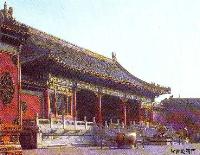 |
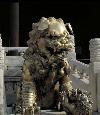 The Qianqingmen 乾清門 "Gate of Sovereign Pureness" is the entrance to the Inner Court. Only the highest eunuchs were allowed to enter the Inner Court, where only the emperor, his main and minor wifes, and the servant maids lived. Only during a few occasions, the highest minister or diplomats were allowed to enter this part of the Forbidden City. In front of the Qianqingmen stands a golden bronze lion. The Qianqingmen 乾清門 "Gate of Sovereign Pureness" is the entrance to the Inner Court. Only the highest eunuchs were allowed to enter the Inner Court, where only the emperor, his main and minor wifes, and the servant maids lived. Only during a few occasions, the highest minister or diplomats were allowed to enter this part of the Forbidden City. In front of the Qianqingmen stands a golden bronze lion. |
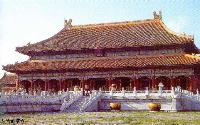 |
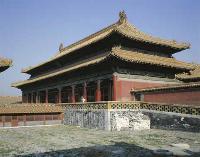 The Qianqinggong 乾清宮 "Palace of Sovereign Pureness" originally served as sleeping palace for the emperor during the Ming Dynasty and later was used to receive foreign diplomats and envoys. The Qianqinggong is the first of another trinity complex, the second being the Jiaotaidian 交泰殿 "Hall of Unification of the Highest Beings", the residence of the empress and storehouse for the imperial seals (no picture, resembles the Zhonghedian, but smaller), and the third, the Kunninggong 坤寧宮 "Palace of Compliant Peace" (or Terrestrial Peace; Earth as symbol of the wife; right), the Qing time sleeping rooms of the emperor in the wedding-night. The Qianqinggong 乾清宮 "Palace of Sovereign Pureness" originally served as sleeping palace for the emperor during the Ming Dynasty and later was used to receive foreign diplomats and envoys. The Qianqinggong is the first of another trinity complex, the second being the Jiaotaidian 交泰殿 "Hall of Unification of the Highest Beings", the residence of the empress and storehouse for the imperial seals (no picture, resembles the Zhonghedian, but smaller), and the third, the Kunninggong 坤寧宮 "Palace of Compliant Peace" (or Terrestrial Peace; Earth as symbol of the wife; right), the Qing time sleeping rooms of the emperor in the wedding-night. |
 |
Fire is the greatest danger for buildings almost thoroughly erected of wood. The pillars of the main halls, made of huge trees and coated with red lacquer, have to sustain a wood construction weighing hundreds of tons, not to speak of the weight of the glazed tiles on the roof. To prevent buildings catching fire from lightnings, all over the Forbidden City we find kettles filled with water that serve as first aid in case of fire. The kettles on the left nevertheless are no water kettles but containers for perfume sticks that were incenced during ceremonies worshipping the emperor's ancestors in front of the Qianqinggong. |
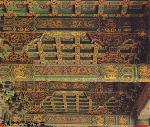 |
While the outside of Chinese dwellings is very austere and almost without any decoration - stone paved floors, stone railings and stairways - the interior does add only a few items to create a more comfortable atmosphere. Almost the sole decoration of the inner part of the palace buildings are the coffered ceiling (zaojing 藻井), held in green background and depicted with golden dragons. The example to the left is from the Taihemen. |
 |
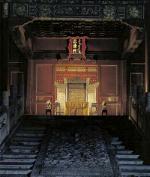 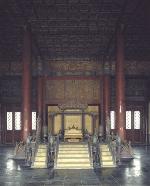 As all buildings described above had representative character, all of them were equipped with a throne. The picture to the left shows the throne (baozuo 寶座) in the Qianqinggong, the throne representing the Chinese empire to foreign countries. On top of the hall is written "The correct (way) is gleaming in enlightenment" (Zheng da guang ming 正大光明). The two pictures to the right show the throne in the Qianqing Gate (right) and the Baohe Hall (left). As all buildings described above had representative character, all of them were equipped with a throne. The picture to the left shows the throne (baozuo 寶座) in the Qianqinggong, the throne representing the Chinese empire to foreign countries. On top of the hall is written "The correct (way) is gleaming in enlightenment" (Zheng da guang ming 正大光明). The two pictures to the right show the throne in the Qianqing Gate (right) and the Baohe Hall (left). |
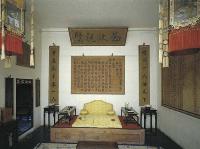 |
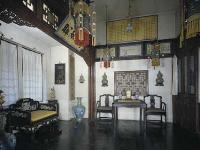 One of the few private buildings that can be visited in the Forbidden city is the Yangxindian 養心殿 "Hall of Nourishment of the Mind" (west to the Qianqinggong) where the last few emperors of Qing Dynasty had their living quarters. Here we can see the objects and items the emperor needed for his private life and leisure time. One of the few private buildings that can be visited in the Forbidden city is the Yangxindian 養心殿 "Hall of Nourishment of the Mind" (west to the Qianqinggong) where the last few emperors of Qing Dynasty had their living quarters. Here we can see the objects and items the emperor needed for his private life and leisure time. |
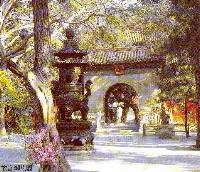 |
The Imperial Garden Yuhuayuan 御花園 is located just to the south of the northern gate. Like all Chinese gardens, this relaxing part of the Forbidden City is a demonstration of an artificial scaled down universe with artificial mountain, rocks trees and flowers. Chinese gardens show the tendency of the Chinese thinking to standardize everything. The black bronze kettle in the middle is an over for burning paper money and incense sticks for the ancestor veneration. |
 The summer residence of the Manchu emperors in Mukden (Shenyang 瀋陽/Liaoning) seems to be a small copy of the Imperial City in Beijing. In fact, buildings for every need were erected to keep the huge imperial household with its thousands of employees when the emperors used to go to hunt in the Manchurian hills. But the small houses also show that the living conditions of the imperial staff was less than comfortable. The summer residence of the Manchu emperors in Mukden (Shenyang 瀋陽/Liaoning) seems to be a small copy of the Imperial City in Beijing. In fact, buildings for every need were erected to keep the huge imperial household with its thousands of employees when the emperors used to go to hunt in the Manchurian hills. But the small houses also show that the living conditions of the imperial staff was less than comfortable. |
|
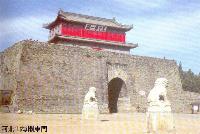 |
The Shanhaiguan 山海關 "Mountain and See Pass" is the eastern end of the Great Wall (Changcheng 長城) of China. This fort was erected during the Ming Dynasty 明 when the Yongle Emperor 永樂 had rebuilt the Great Wall to impede the restrengthened Mongol nomads to invade Chinese territory. This pass or fortress was controlled by Wu Sangui 吳三桂 who decided to collaborate with the Manchu invaders in 1644 and allowed them to pass this strategical point. |
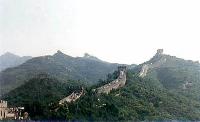 |
The Great Wall (Changcheng 長城) was first built during the Qin Dynasty 秦 as a means of defension against the belligerent nomad peoples like Xiongnu 匈奴 in the steppe of modern Mongolia. Although it has only little effect in the course of history against intrusions and attacks of nomad tribes, the wall was rebuilt during the Ming period 明. The most popular part of the Great Wall are the reconstructed fortifications north of Beijing, Badaling 八達岭 being the most frequented tourist site. The eroded western parts of the Great Wall in modern Gansu Province are much less attractive. |
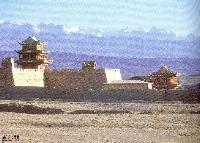 |
The opposite end of the Great Wall is the fortress at Jiayuguan 嘉峪關 "Jiayu Pass" in Gansu. Although Chinese soldiers proceeded far beyond that point and could convince or force Inner Asian peoples like the Xiongnu 匈奴 or Tujue 突厥 (Türks) to pay tributes to the Chinese emperors and to accept them as overlord, the Jiayu Pass was the most exponed fortress that protected Chinese commanderies. The pass was first conquered by Emperor Han Wudi 漢武帝 and since belonged to the Chinese Empire except the period of North-South Division 南北朝 and the Song period 宋 when Non-Chinese rulers occupied this part of China. The territories west of the pass did not really belong to the Han 漢 or Tang 唐 empires but because the Chinese emperors had a deep interest into the control of the Silk Road they established protectorates and often interfered into the politics of the nomad tribes and the city states of the Silk Road. |
|
|
|